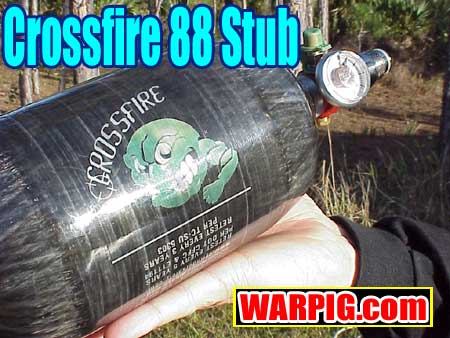  |
|
|
|
|
|
|
  |
|
|
|
|
|
|

What
do you think?
|

Crossfire 88ci system By Bill Mills In the early days of compressed air for paintball, players had two choices – Air America and Paintball Mania. In the later 1990s, a third name jumped into what is now a more diverse market – that new brand was Crossfire. While other manufacturers have produced product lines with a large number of regulators boasting different features, Crossfire has focused on producing a reliable screw-in air system that requires no maintenance or expertise to operate.
The Crossfire regulator reviewed was a high pressure output 4,500 psi model mounted on an 88 cubic inch “stubby” tank. Tank selection is an area where the Crossfire line stands out. Because they work directly with Carleton cylinders, they offer a wider variety of tank options than some of their competitors. Their 72 cubic inch “shaved” tank and 88 cubic inch stubby are great examples of configurations not carried under by all of the other brands, especially those offering lower cost presets. Both of these “stubby” tanks are wider than standard tanks of the same volume, making their overall length shorter in comparison, allowing the player to hold their paintgun tighter up against their body.
On the field, the Crossfire system performed admirably. It was tested on an Automag RT, E-Mag, E-Matrix, and Angel IR3. In each case there was no noticeable problem with shootdown or slow recharge. Slow recharge can be a problem with some compressed air systems. It happens when the regulator can not move air into the paintgun fast enough to maintain a steady air pressure under rapid fire. Crossfire regularly demonstrates their regulators side by side with the systems of their competitors at paintball trade shows, allowing customers to see the pressure changes on gauges as the paintguns are fired.
Overall the Crossfire system performed without any problems. The size and performance made it an effective air system, and the convenience of simply screwing it in to a paintgun makes it an easy upgrade from CO2, and easier to pack for travel when compared to the mounting and hose systems used on adjustable output air systems.
|
| Copyright © 1992-2019
Corinthian Media Services. WARPIG's webmasters can be reached through our feedback form. All articles and images are copyrighted and may not be redistributed without the written permission of their original creators and Corinthian Media Services. The WARPIG paintball page is a collection of information and pointers to sources from around the internet and other locations. As such, Corinthian Media Services makes no claims to the trustworthiness or reliability of said information. The information contained in, and referenced by WARPIG, should not be used as a substitute for safety information from trained professionals in the paintball industry. |